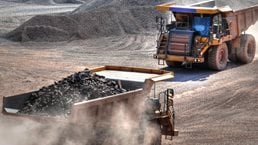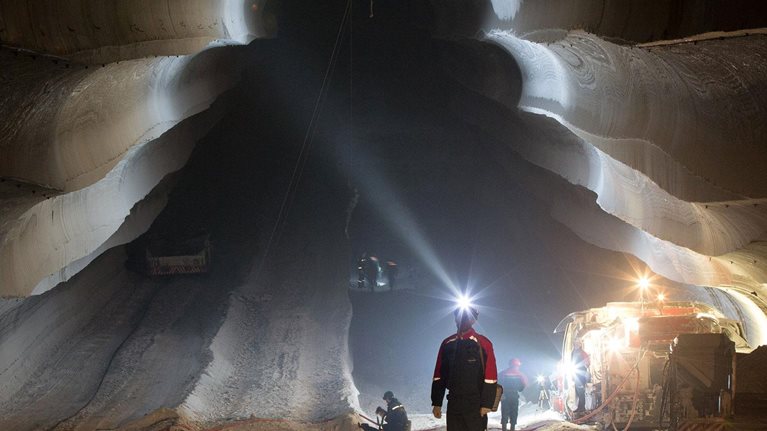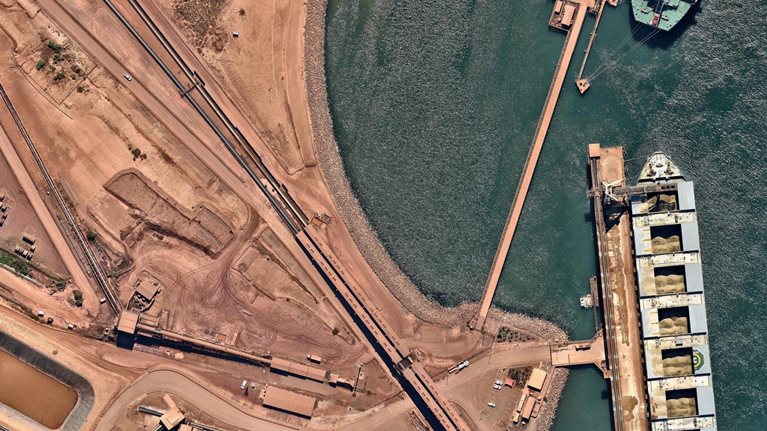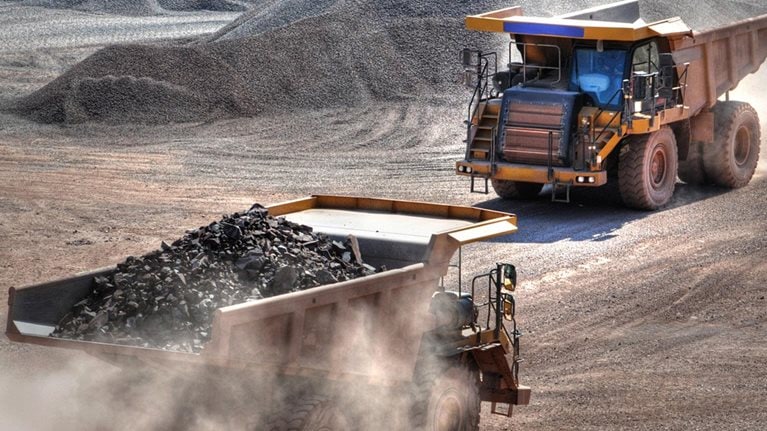McKinsey Metals & Mining published a 2015 paper that predicted a technology-enabled transformation of the mining industry. The paper identified some potentially game-changing innovations that we believed would revolutionize the way mines operate and deliver much-needed productivity gains.
Stay current on your favorite topics
Since then, many of these innovations have lived up to that potential. Digital technology—when implemented with management and mindset changes—is leading to meaningful operational improvements. For instance, advanced analytics and sensors are helping lower maintenance costs and decrease downtime while boosting output and chemical recovery. Robotics and semi-autonomous equipment are taking humans out of mines, reducing costs and risk. In Western Australia, miners using autonomous haulage technology have reported a 20 percent improvement in productivity.
Not coincidentally, according to McKinsey research, overall mining productivity rose about 2.8 percent per year from 2014–2016—a period of modestly rising output. Two main trends underlie these productivity gains: an increase in labor productivity that has enabled a 3 percent annual reduction in headcount, and tightly controlled capital spending and expenditures for non-labor operations (Exhibit 1).

Some of the credit for this improvement must be given to the maturation of lean management, lean operating systems, and Six Sigma improvements. But those improvements will be harder to sustain. Every year, the work becomes more difficult. Ore grades are declining, while water scarcity has threatened to strand assets in the ground, and operating licenses have become more difficult to obtain.
Technology—particularly artificial intelligence (AI) and machine learning, automation and robotics, mobile digital, the Industrial Internet of Things, and modern data architecture (including the cloud)—can help the industry meet these and other challenges. It may also help reduce the industry’s environmental footprint, move workers out of harm’s way, turn uneconomical reserves economical, and make work less repetitive and less strenuous.
Yet many companies are still struggling to embrace tech-enabled transformation. In our experience, getting the tech right is just part of the puzzle. There are many examples of companies that have invested in technology and not seen improvements because they neglected the other vital engines of tech-enabled transformation, management systems, and culture.
Three engines for driving technology-enabled change
Achieving sustainable change requires more than a focus on the technology. Just as with lean or Six Sigma-driven improvement, companies need to adopt a holistic approach to transformation. There is no technological silver bullet that companies can buy to achieve their goals. Instead, there are three interdependent engines that drive either a transformational or smaller-scale technology-enabled operating system change (Exhibit 2). These are:
- Harness technology, including digital, analytics, and automation across the organization, to solve the key challenges of productivity, safety, customer satisfaction, and supply chain management.
- Adapt the management systems (such as work processes) to enable the company to realize the potential offered by the new technologies.
- Overhaul the culture and capabilities to achieve a more agile, responsive organization that can get value from and adapt to modern technologies.

1. Harness technology
The many improvements mining companies have achieved by harnessing modern technologies include:
Improving throughput and recovery
At some mines, advanced analytics systems are ingesting all the data in the concentration environment and using it to improve processes. Instead of achieving the local optimum through automatic process control, this approach delivers a global optimum. Doing that can boost yield energy throughput. Today, it’s not unusual to see opportunities to raise mineral recovery by 1 to 3 percent and increase throughput by 4 to 8 percent, while reducing energy consumption. This can mean a productivity boost of 5 to 10 percent, which equates roughly to opening a new mine if applied across a typical mining company’s footprint, without the capital cost.
One metal mine is using advanced analytics and machine learning to develop an “industrial controller of controllers” to drive up throughput and mineral recovery. The company is collecting data from more than 150 sensors for medium to large concentration plants. An algorithm predicts the behavior of a plant and offers a series of recommendations to optimize based on controllable variables. The plan is reviewed by the plant supervisors, who adopt the suggestions that make sense and question those that don’t. The impact of the implemented changes is measured on an ongoing basis to refine the program.
Would you like to learn more about our Metals & Mining Practice?
In another example, a metal mine used Industrial Internet of Things sensors combined with a centralized data repository and advanced machine learning, to boost chemical recovery from the extraction process by 10 to 15 percent. Sensors collect real-time data from the waste, and the machine learning model calculates the optimal parameters for recovering (for instance) sodium hydroxide, boosting performance above that which operators were previously able to achieve. This has saved millions of dollars’ worth of chemicals and reduced the environmental impact of the tailings.
Optimizing maintenance
Technology is helping mines conduct maintenance when it is needed rather than on a fixed schedule. One company used sensors and machine learning to implement predictive maintenance in very large (20-ton) heat exchangers. The model was able to predict when the exchangers would fail, reducing maintenance from once every 70 days to as long as once every 160 to 200 days. Given that there were dozens of heat exchangers, the cost savings have been substantial.
Maintenance workers can benefit from technology as well. Workers responsible for pumps now can carry a phone or tablet that knows where the workers are and the assets on which they’re working. The system can bring up the maintenance history of a particular asset, display a work order, and show the steps that need to be carried out to complete the job. This may include details such as the torque level for tightening a nut, or instructions for inserting an O-ring. In the years ahead, augmented reality will increasingly serve this purpose, even having an expert from the asset’s manufacturer appear (virtually) to help the worker.
Reducing operating costs
Some of the most far-reaching changes in mining are likely to emerge from the use of robotics. Autonomous equipment operates continuously, with less variability and virtually always within the manufacturer’s recommended tolerances, reducing maintenance as well as headcount. Additionally, compared to human-led processes, robotic consistency can be more amenable to continuous improvement methodologies. This has a broad impact on a variety of processes, ranging from road maintenance to how to back into a shovel location.
Commercial autonomous haul trucks now have been proven viable for open pit mines that have a suitable cost structure. These trucks drive themselves between loading and dumping. Another increasingly common machine is the autonomous blast-hole drill, which will drill a complete pattern without intervention. In a production environment, groups of three or more autonomous bulldozers are now able to coordinate overburden removal.
Underground, mines are starting to use tele-remote load, haul, and dump (LHD) machines. Bigger mines have moved from pilot-scale deployment to adopting LHD as their new standard. For one mining company, autonomous haulage system trucks have yielded a 20 percent productivity increase. Another early adopter has recently decided to expand its fleet of autonomous vehicles based on their productivity results.
Automation will help operators be more efficient and focus on developing new expertise. For example, instead of using ever-larger equipment, operators can optimize size to balance maintenance costs with haulage cost per ton.
Boosting productivity and overall equipment effectiveness (OEE)
Coordinating activities in underground mining has always been a challenge given the difficulty in knowing where people and assets are and how much progress they have made. It has become increasingly realistic to combine off-the-shelf technologies with in-house solutions to create a system that improves transparency, safety, performance monitoring, and overall equipment effectiveness. By deploying underground networks—using WiFi or 5G wireless technology, for example—a mine’s supervisors can communicate with work teams in real time. This single innovation can have far-reaching ramifications, provided it is implemented in tandem with the other two key engines of technology-enabled transformation: adapting the management systems and overhauling the culture. (See sidebar, “How digital communications can change the way a mine operates.”)
2. Adapt the management systems
Companies must commit to transforming their management systems to nurture innovation and embrace change and technology. For example, a mining company that is using advanced analytics to increase yield and throughput also needs to modify how metallurgists, plant operators, and maintainers work together to embed the new tools and insights into their daily workflow. Otherwise, the actual operation of the plant does not change, and the bottom-line benefit cannot be achieved.
The organization sometimes requires modifying, too. Traditional mining operations tend to be organized around separate teams responsible for production, maintenance, planning, and the like. This approach is not appropriate for a digital organization, as it leads to slow and inferior decision making. Each team sees only its part of the whole, and when problems arise (as they always do), it works against collaborative and cooperative thinking and action. Most importantly, teams that work in siloes know only what they know; they are isolated from the data that drives innovation.
Embracing technology means that individuals who have traditionally not had much need to work together are now highly dependent on each other and need to be organized in a way that allows for this. We have found that the most effective way to take advantage of new technologies is to reorganize workers into “squads” (when appropriate; safety is always a paramount concern) that include people with varied and complementary skills. This working team focuses on a specific process or set of assets — say, a leaching operation — and has a range of skillsets that allow them to make more informed decisions and meaningful changes faster.
Squads benefit from including or having ample access to coaches, data scientists, programmers, and whoever and whatever else they need to achieve their goals. They perform best when they are empowered to make decisions and deploy resources. One company reaped significant improvements by enabling its teams to invest up to $100,000 without additional approvals.
3. Overhaul the culture and capabilities
Technology-enabled transformation calls for a break from ingrained habits, and a change in mindsets, behaviors, and capabilities.
Making changes to where decisions are made and who makes them requires a change-management program. An effective plan will enable employees to understand how a technology-enhanced system will make their lives better, safer, and more productive. This understanding has to be reinforced through formal mechanisms, and managers must model new behaviors. (See sidebar, “How one company changed its culture and infrastructure.”)
Of course, harnessing technology also means training employees and hiring new staff with advanced skillsets to fill a variety of new roles. Data scientists are needed to develop sophisticated analytics models to identify improvement levers. If a mining company is using an agile development approach, other skills and roles are needed. One such role is the product owner, who has multiple responsibilities, including acting as the voice of the end-user, testing and reviewing each iteration of a product. Another is the scrum master, who oversees the design process, fostering cooperation across roles and functions and removing obstacles (Exhibit 3).

Today, these skills are scarce, so companies will have to develop their own capabilities. They can do this, for instance, by creating advanced analytics academies to establish data science skills, such as coding. Companies can also deploy translators who have the skills needed to interpret systems for other employees at the mine. In many cases, companies will be able to harness existing talent to fill the translator role, drawing on younger digital natives or others with a passion for technology. A US-based base-metals client found an in-house metallurgist who was passionate about technology and quite sophisticated on highly relevant technical aspects of machine learning models. The company trained her as a machine learning controller of controllers. Her hobby enabled her to design a high-quality user interface for use in a processing plant.

Productivity across the global mining sector is starting to improve
Human resource departments must play a vital role in shifting the mining culture, enabling these new classes of professionals to thrive and realize their potential. Retaining these employees is also essential. Company results improve when capabilities are built not just on a project basis, but for the long-term.
No silver bullet
Management teams must realize that tech-enabled transformation is a journey unique to every company and mine, not a one-off application of use cases. There are no silver bullets and no one list of technologies that every company should implement. There will be hundreds, and ultimately thousands, of ideas, improvements, and use cases. Some of these can be done now; others will unfold as a company’s capabilities and technical architecture develop. Leaders should also expect some initiatives to work and others not to work. They should not lose faith; transformation requires continuous and determined effort.
Where companies choose to embark on the journey will depend on the maturity level of their process controls and data systems; some companies will need to improve and stabilize their underlying systems. As the transformation unfolds over time, companies will learn, and their capabilities will grow. Technology will evolve, too, and those that embrace the management and cultural changes central to technology transformation will have the skillsets—and more importantly the mindsets and processes—to evolve with it. They will continue to get better at driving productivity and improving safety.
The maturity of specific technologies is also a critical consideration. Leaders will need to determine which are suitable for application today versus in the near- or midterm future. No mine will want to get caught in an unexpected R&D project.
We recommend a company start by identifying a use case that will provide a high return on investment. Today, the best opportunities tend to be in automated equipment, pit-to-port supply chain improvements, optimized scheduling and control, yield optimization, and maintenance, including predictive strategies, digitized planning, and digitally enabled execution (Exhibit 4). Of course, initial and subsequent undertakings need to be part of a broader plan and ambition.
Tech-enabled transformation opens up a whole new horizon of possibilities. It equips companies with novel levers, tools, and opportunities to improve safety, productivity, and ways of working. The rewards will be far-reaching for companies that commit to it and approach it wisely.



